There are many things to consider before stepping out into the great outdoors, a feat in which being over-prepared is, in many cases, beneficial. Of course, everyone’s pack, and most importantly, their first-aid will look different based on which sector of the outdoors they plan on venturing out to; from a run through the local park to forging out to the bush.
Depending on your geographical location, and the time of year, your first aid should contain the basics according to these elements. One of these first-aid basics includes bee sting treatment and remedy for bee stings. It may sound like something medial, but it is important to be prepared for even the most simplistic problems you may encounter. Being prepared for the small things that typically overlooked will ensure that something small will not change the course of your trip.
Bee and wasp stings fluctuate in severity based on the person. Every person based on their genetic makeup will react differently. Therefore, it is important to gauge what your reaction might be, and plan accordingly. Having a thorough knowledge of your allergies and reactions is important on what to have on you at all times. If you have no allergies, ice packs, cleaning wipes, and ibuprofen will typically be sufficient in your first-aid.
However, if you are prone to allergic reactions, or any other systemic reaction, talk to your doctor about what you can bring along with you and steps to take in the case a reaction does happen. Keeping up to date on your shots is a good thing to consider, as routine immunizations such as the tetanus shot, can increase immunity in your body and fight off infection or reactions to things like bee stings. If your immunization is not current, you’ll most likely receive a booster shot if you have had a severe reaction to a sting.
Types of Bees
Before we continue with our text, it is important to get familiar with types of bees and their natural behavior, so that you can easily identify the type ot he bee that stung you, or to know where to expect them and what to expect from them.
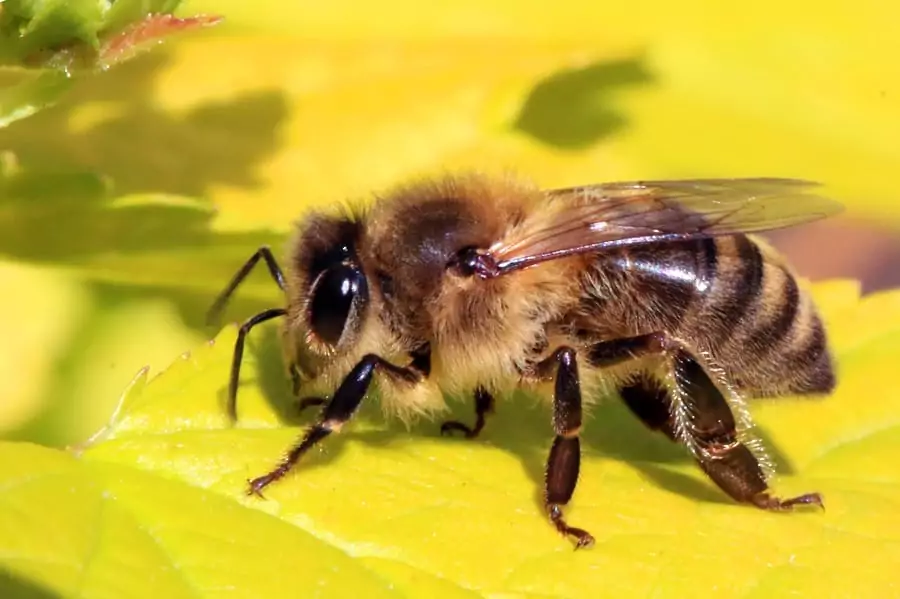
Although there are around 25,000 known species of bees around the world, all belonging under the Super-family “Apoidea”, you won’t find the majority in your backyard. If you reside within North America, here are the most common bees you’ll see:
- Honey Bee. Classified as the ‘Social’ bee, the Honeybee will live in colonies consisting of around 50,000- 60,000 workers. Honey bees play an important role in conservation and used extensively in crop pollination.
- Bumblebee. Bumblebee colonies will comprise of about 50 to 400 workers.They are excellent pollinators of all kinds of flowers, their efficiency due to their furry body shape and their ability to buzz pollinate.
- Carpenter Bee. Carpenter Bees are solitary, and make nests for boring holes in wood. They use mall amounts of wood chips to form partitions between the cells in which they lay their eggs. This species lays the largest egg of any insect!
- Leaf-cutter Bee. Leaf-cutters like hollow stems and ready-made holes in wood. These bees belong to the You might notice their effects in the garden by a small cut in the piece of the leaf which it takes to construct its egg cells.
- Miner Bees. Mining bees are solitary and will excavate tunnels and cells underground for nesting and pollination purposes. They prefer sandy soil, but can be found throughout many gardens.
What Happens?
When a bee or wasp stings a person, they inject venom through their stinger into the skin of the victim. The difference between the two stings is that a bee has a barbed stinger that remains in the victim’s skin with a venom sac attached while wasps gave stingers without barbs, retracted upon stinging.
This is why wasps can typically sting people multiple times while stinging people results in the bee’s fatality.
Bee venom, or apitoxin, is a colorless liquid made up primarily of proteins, which cause the inflammation and symptoms of a sting. A typical honey bee can inject approximately 0.1mg of venom, and the typical adult, without a severe allergy to the sting, can withstand about 10 stings per pound of body weight.
As soon as a bee sting occurs, remove the stinger at once as it takes a mere second for the venom to enter your bloodstream. If the venom enters the bloodstream, it will prolong symptoms, create a greater chance of infection, and if prone to an allergic reaction, make the reaction more severe.
It is important when removing the stinger to not grab the end and pull it out. The venom sac is delicately attached to the end and may release more if pulled out this way. Instead, scraping the stinger out is a proven safe way to take out the stinger.
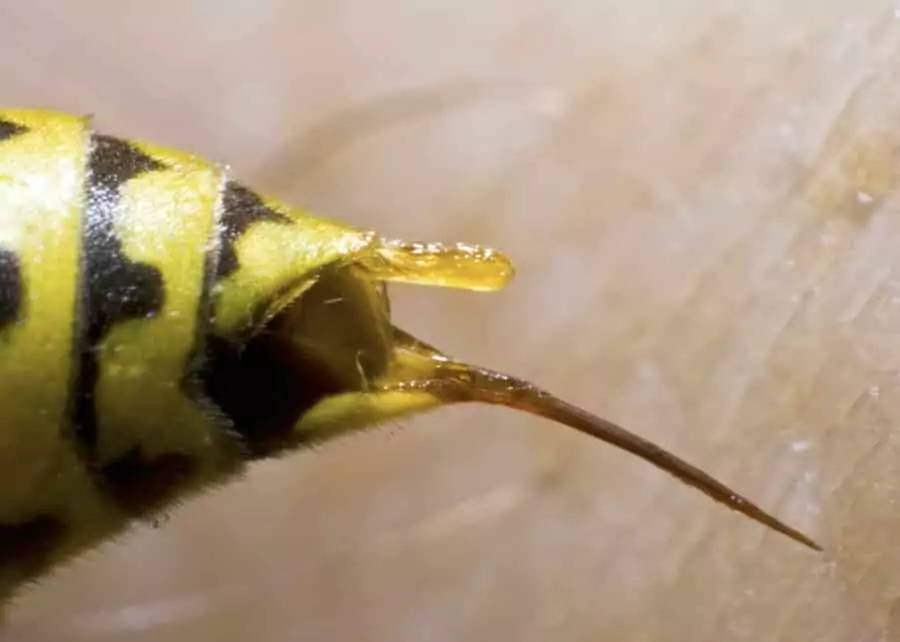
You can do so with your finger, or many recommend using a credit card. The stinger, upon release into your skin, will also release a pheromone that signals to others bees that you are a threat.
This doesn’t necessarily mean that a swarm of bees will come straight for you, however, it’s smart to remove the stinger in a timely manner as to prevent the bees reacting to the pheromone.
After removing the stinger, wash the sting area with soap (unscented) and water. After the area has been thoroughly cleaned, apply a cold compress or ice to relieve pain and ease the swelling.
Avoid putting ice directly on the body, and instead, wrap in a compress or cloth, to keep from freezing the skin. Apply ice for 20 minutes once an hour as needed. Gauge what type of reaction you have, and perform an appropriate treatment or remedy accordingly.
Wasps, similarly, are equipped with a stinger for self- defense, but unlike the bee, the stinger will remain intact. Wasp venom will inject into your skin without the removal of the stinger and can cause quite significant pain and irritation.
The treatment for the sting is exactly the same as that of a bee, and the reactions will look very similar. The major difference you’ll notice will be a raised welt around the sting site, with a white mark visible where the sting punctured the skin.
Treatment
Treatment for a bee or wasp sting depends on the severity of the reaction to the sting. More often than not, degrees of a localized reaction will occur, and the treatment is straightforward and does not pose any need for further medical assistance.
To tell if it is considered a normal reaction, the skin will be reddened and painful, and swelling and itching may occur. This end of the spectrum results in the pain disappearing over a few hours and symptoms will not typically persist.
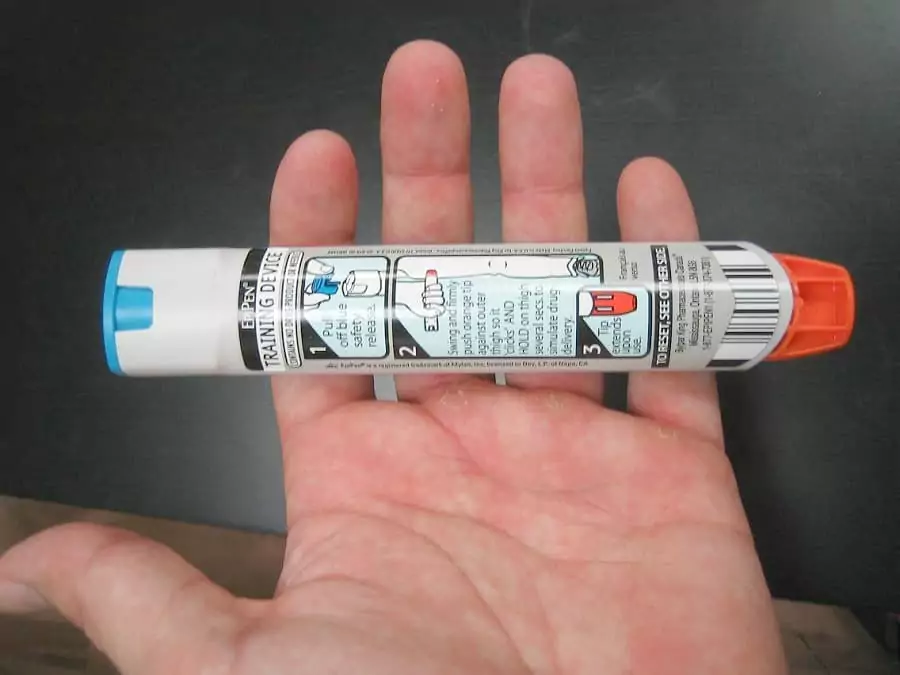
In some cases, the local reaction will last about a week, and surrounding areas of the skin may be affected. In all of these localized reactions, that is to say, a reaction that does not cause a severe allergic reaction, home treatment is enough, and repeat the steps taken right after the sting will be sufficient.
If there are multiple stings that cause a localized reaction, and there is no evidence of an allergic reaction, take precaution and seek a further medical assistance. You may need prolonged observation and blood tests done by doctors to determine the level of venom that was released into the bloodstream.
Bee Sting Remedy
Most of these localized reactions can be helped along using home remedies or things found over-the-counter at your local drugstore. These remedies will help make the healing process go faster, as well as decrease swelling and pain associated with the sting.
Taking an antihistamine such as diphenhydramine (Benadryl) or loratadine (Claritin) will help the itching and swelling and ibuprofen (Motrin) or acetaminophen (Tylenol) will help with pain relief. A hydrocortisone cream on the sting and surrounding area can also help relieve redness, itching, and swelling.
Here’s our article on the best sting remedies to help you deal with any emergencies and tips to prevent it.
Home Remedies for Bee Stings
If you’re not a big fan of medications, sodium bicarbonate (baking soda) is an agent that is known to help relieve swelling and soothe itching. Add enough water to a bit of baking soda to create a paste, and apply to the affected area.
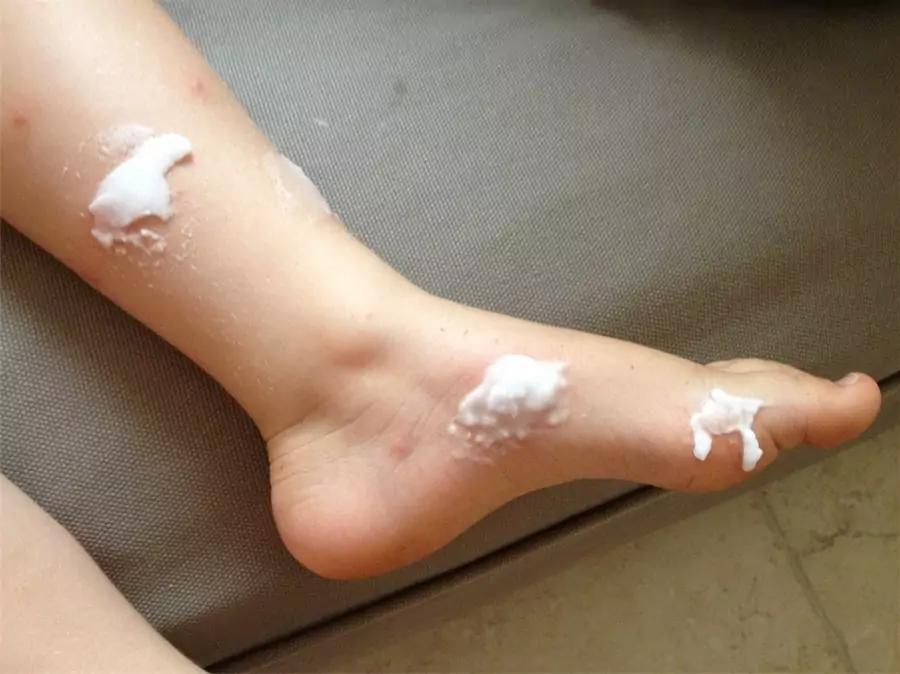
Lavender essential oil is also known to soothe and ease discomfort in a sting. It is recommended to use the oil undiluted, and apply it right to the affected area. It can reduce itching, help with swelling along with easing the discomfort of the sting.
That being said, ensure you are not prone to skin irritation brought on by essential oils, or this will make the skin around the sting more irritated.
The majority of problems that require further medical assistance come from an allergic reaction to the sting. We’ve discussed local reactions, which can be easily tended to with home remedies or over-the-counter medications.
About 10 percent of people have adverse reactions and they are referred to as a “large local reaction”. This can be any other reaction other than pain, swelling, redness and itching, and may come in the form of dizziness and difficulty breathing. If you are experiencing these symptoms, or if you are experiencing any greater reaction (which would suggest an allergy), you should be taken to the emergency room to seek medical help.
How Will I Know it’s An Allergy?
Approximately 3% of people who are stung by bees or wasps have allergic reactions to the sting, and the only way to know if you have an allergy to a sting is to confirm it with a doctor. If your first sting proves to be incredibly reactive and is proving severe, seeking further medical help is imperative.
You’ll want to confirm if it’s an allergy, and not just a localized reaction, as all allergic reactions will need further medical assistance. If you are aware of your allergies and happen to get stung, call 911 or get someone who is with you to drive to the nearest emergency room.

Treatments can start as early as at the scene or in the ambulance and will be monitored in the emergency department. In the moderate to severe cases, you may be admitted to a hospital.
A mild allergic symptom might appear as a rash over your body but will not compromise your breathing or other vitals. A symptom such as this would require further medical assistance and you would likely receive antihistamine, steroid, or epinephrine injections.
A moderate allergic reaction to a sting yields a low blood pressure, swelling in the esophagus, or other problems breathing. This is a cause for emergency and can be treated by professionals with injections, and intravenous fluids.
The most severe allergic reaction is the life-threatening anaphylaxis., and up to 0.8% of victims experience this reaction. During an anaphylactic attack, an emergency medical team may perform cardiopulmonary resuscitation (CPR) if you stop breathing or your heart stops beating.
Therefore, it is crucial that if you are prone to an anaphylactic reaction to triggers such as bee and wasp stings, to carry prescribed epinephrine (EpiPen), or its equivalent, at all times.
Make sure that you know how to use the EpiPen, as well as others who are with you in the case of an emergency. All three of these reactions differ from localized reactions, and can not be treated with home remedies.
Also, make sure to read our timely piece on the list of medical supplies needed for first aid kits.
Prevention
Avoiding further stings is fairly straightforward. It is recommended to wear protective clothing, long shirts, pants, thick layers etc. as stingers have a tougher time getting through layers of fabric as opposed to exposed skin.
Knowing infested areas is also a great way to prevent coming in contact with bees and wasps. Doing your research beforehand or playing it by ear when you’re out is crucial to sidestepping a possible sting.

Therefore, it’s important to keep your eyes at the ready for nests, and other habitats of bees and wasps.
If you do find yourself near a hive, calmly move away and do so with ease. Any large reaction or disruption will upset the bees and you are more likely to cause stress within the insects.
As complete avoidance of a bee or wasp is unavoidable if you’re outside, I recommend packing an insect repellent that specializes in bees and wasps. Spraying yourself and repeating this process every few hours will, along with extra layers and avoidance, nearly guarantee your chance at avoiding a sting.
Bee and wasp stings are very common, especially during the warmer months and during the pollination season. They can be painful and uncomfortable, but as we’ve found out, more than 85% of people will have a small, localized reaction that can be treated quickly and without complication.
Learn what to wear during camping trips to stay protected by reading our article on this topic.
Interesting facts about bees
- There are over 4,000 species of bees in North America alone.
- Bees tend to be thought of as just yellow and black, but can actually be found in a wide range of colors. They can be amber, metallic green or deep metallic blue-black, and can have turquoise or emerald eyes.
- 70% of native bees nest in the ground and most are solitary- meaning they do not live in a hive. The social nature of bees is one that is considered quite odd within the insect species.
- Beekeeping is no longer only for professionals, and becoming a ‘Hobbyist Bee Keeper’ has grown widely popular in the last decade.
- Bees will only sting you if they feel threatened or if their home is in danger. Otherwise, bees are quite pleasant and non-aggressive insects.
- Yellow-faced bees are now on the Endangered Species in North America List. Yellow-faced Bees are native to Hawaii.
In Summary
Now that you know what can happen if a bee stings you, what to do and use in such an event, and even which types of bees can appear in certain areas, you can confidently plan your next adventure in the great outdoors.

But, just to make sure, we have also included the symptoms that can tell you if you can handle the sting on your own or you need to go and seek doctor’s help.
The symptoms that suggest that you are experiencing a normal or large, local reaction (both of which can be treated at home):
- Pain
- Itching
- Swelling
- Redness
- Irritation
- Rash
Symptoms that would suggest an allergy:
- Hives
- Difficulty breathing
- Dizziness
- Low blood pressure
- Lightheadedness
- Loss of consciousness
- Nausea or vomiting
- Diarrhea
- Stomach cramps
- Weak or racing pulse
Don’t forget to check out our article on DIY insect repellents that will keep you protected from other harmful insects and pests.
We hope that you found our article informative and useful. If you feel like you want to share some of your experiences with bee stings, or you think that we left something out, feel free to leave a comment in the comments section below.

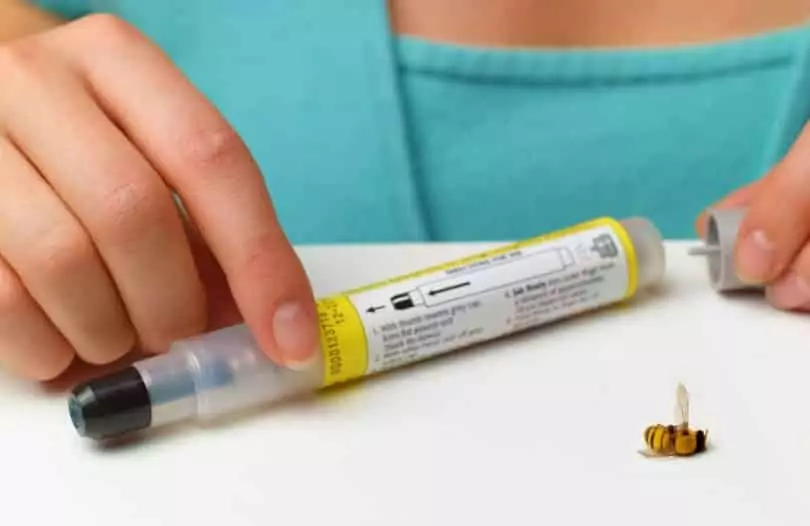






Very important safety tips, thank you for sharing. Now I know how to avoid getting stung by bees while on my commune with nature, and anywhere else. It is also reassuring to know what to do in case I am stung and the signs of an allergic reaction. I hope I never get stung, but just in case it happens, I know what to do.
I have a couple of antihistamines in my first aid kit as a precautionary nature. It’s good to know that these meds can take care of any reaction that might occur. I’m glad the article helped you and will be useful in the future.
Watch out for those bees! 🙂
This reminds of the time my daughter was stung by a bee and we did not know what to do. We were so far away from home and from any clinic so we just gave her some painkillers and encouraged her to hang in there. The poor girl had to endure a swollen lip and two days of teasing from her brothers.
Oh, that’s terrible! Make sure you have the proper remedy on hand since most people have an allergic reaction to bee stings. Bee sting remedies are inexpensive and I hope you add some to your first aid kit at home.